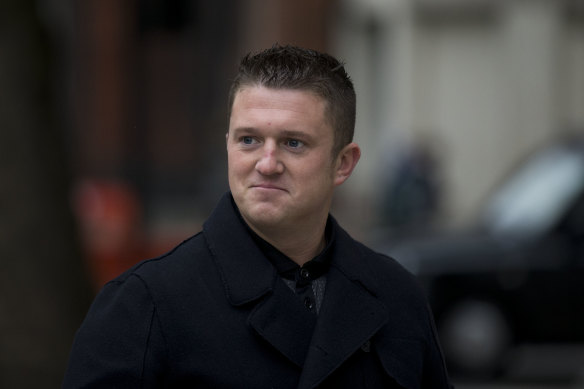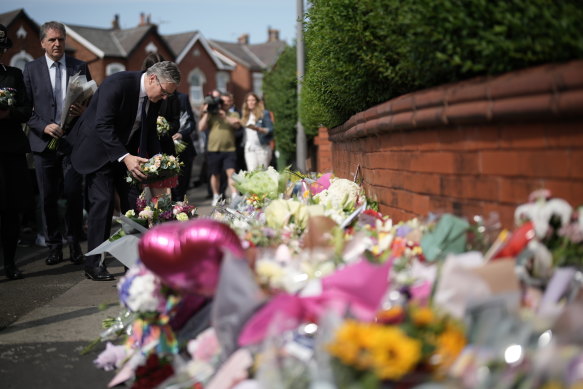
In 2023, 1.2 million people migrated to the UK and 532,000 left, leaving a net migration figure of 685,000, says Britain’s Office for National Statistics. Asylum seekers accounted for 7 per cent of migrants, reported Oxford University’s Migration Observatory.
Where have the riots been?
Hundreds of rioters took to the streets of Southport the day after the attack, just hours after mourners had gathered for a vigil for the girls killed.
A large group of people, who police said included supporters of the far-right English Defence League, threw items towards a local mosque. Meanwhile, a van was set alight, more than 50 police officers were injured and shops were broken into.
Riots spread to Manchester and London the next day, where anti-immigration rioters clashed with police outside Downing Street. Police arrested more than 100 people there after rioters attacked officers and threw flares. In Aldershot, south of London, 200 people rallied outside a hotel used to house asylum seekers.
Disorder continued to spread over the weekend, mostly in the north. Rioters, some wearing masks, smashed windows and lit a car on fire in the town of Middlesbrough, while in Belfast, anti-immigration protests were met with counter-protesters, holding signs reading “no space for hate”.
UK police clash with right-wing protesters in Manchester.Credit: Getty Images
Are far-right figures inciting the riots?
The riots came a week after Tommy Robinson, a British anti-Islam campaigner who founded the English Defence League, hosted a far-right rally in Trafalgar Square in central London.
Robinson, whose real name is Stephen Yaxley-Lennon, played a video during the rally that made false claims about a Syrian refugee. The video had previously led to him losing a libel case in 2021. Monash University professor Ben Wellings, an expert on the politics of nationalism in the UK, says the rally fanned an atmosphere of far-right rage before the attack in Southport.
Less than two hours after the stabbing in Southport, a social media user known as European Invasion posted the false claim on X that the attacker was “alleged to be a Muslim immigrant”, a claim later repeated on Facebook and Telegram.

Tommy Robinson, former leader of the far-right English Defence League.Credit: AP
While various protest movements have opposed immigration in the UK since the 1950s, Wellings says the key difference in these riots is that social media has allowed misinformation to proliferate among networks that might only share a loose connection.
“There may not even be a network in the way that we understand it, but people who are willing to be mobilised on these emotive issues,” Wellings says. “Whether it’s people stoking fears over migration more broadly, or asylum seekers specifically; there could be a mixture of people and mixture of motivations.”
What has the British government said?
UK Prime Minister Keir Starmer has said the rioters came from a minority who “do not speak for Britain.” He has announced a “standing army” of specialist police officers to bolster resources and intends to “ramp up” the criminal justice system to process the large number of arrests.

British Prime Minister Sir Keir Starmer leaves a floral tribute to the child victims of the Southport knife attack.Credit: Getty Images
He has said he expects police to pursue people who have incited violence online as well as those directly participating in the riots. The government has also levelled criticism at social media companies for not doing enough to prevent the spread of misinformation. Bots are also involved that “can be linked to state-backed activity,” according to a spokesperson for Starmer.
British MP Nigel Farage, founder of the far-right Reform party, says the riots are “a reaction to fear, to discomfort, to unease that is out there shared by tens of millions of people”.
Did Australia raise its terror threat level as a result?
ASIO on Monday raised its terror threat level from “possible” to “probable” for the first time in more than a decade. ASIO director-general Mike Burgess said the change came as “more Australians are embracing a more diverse range of extreme ideologies and more Australians are willing to use violence to advance their cause”.
Asked if he was worried about a UK scenario in Australia, he said: “In terms of what’s happening in the United Kingdom, we stay close with our mates and understand what are the drivers there. Every case is different, it’s concerning behaviour, but looking behind that is important.”
Prime Minister Anthony Albanese said in response to the riots that people needed to “turn down the heat” in the political debate, saying, “It breaks your heart to see the anger, which is there from so many people.”
- For more: Elrisala website and for social follow us on Facebook
- Source of information and images “brisbanetimes“




